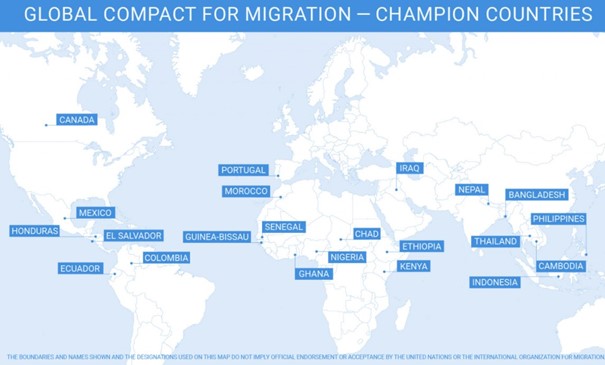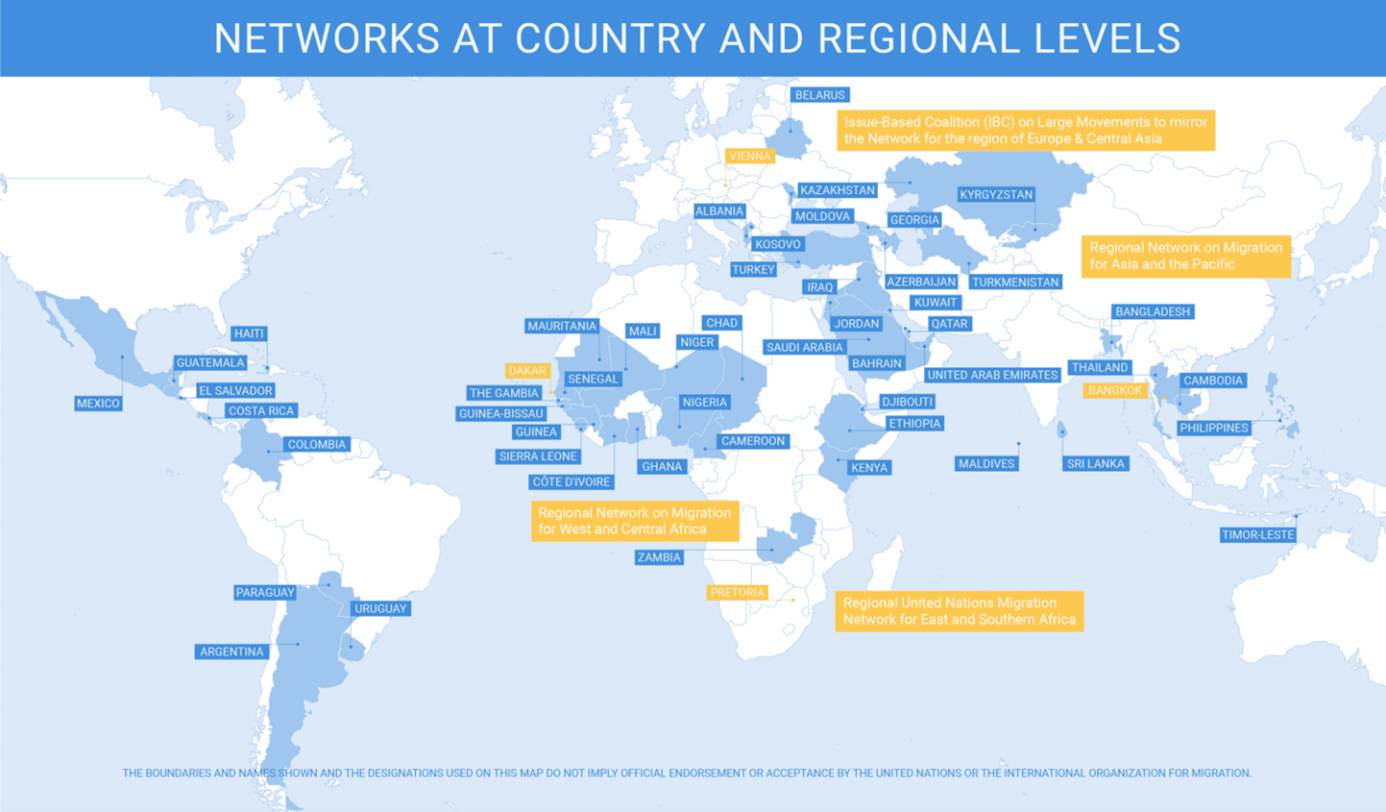In 2018, after two years of negotiations, a large majority of 152 of the world’s states adopted the Global Compact for Migration (GCM), a landmark moment in multilateral migration governance. More than two years in, three questions are emerging: Is the decades-old north–south divide in global migration governance resurfacing? How can we really track whether states are implementing the Compact? And where is the accountability for blatant violation of the Compact’s objectives?
The North–South divide in global migration governance, and the victory of the GCM
Global migration governance emerged iteratively over several decades, from the Cairo Conference on Population and Development in 1994, up to the UN Summit on Addressing Large Movements of Refugees and Migrants in 2016 and the adoption of the two Global Compacts for Migration (GCM) and on Refugees (GCR) in 2018.[1] Throughout this process, we have witnessed a recurrent polarisation between ‘sending’ and ‘receiving’ countries (even though this distinction is artificial and most countries are countries of origin, transit and destination at the same time), represented, broadly speaking, by the ‘global south’ and the ‘global north’[2]. For a long time, there has been a reluctance among states in the global north to bring global migration governance into the United Nations system, due to different perspectives and interests on global migration issues between sending and receiving countries.
A particularly striking example of the North-South divide is the International Convention for the Protection of the Rights of All Migrant Workers and their Family Members (ICRMW) from 1990, the only legally binding multilateral treaty on migration. However, it took until 2003 before the Convention entered into force, after a sufficient number of primarily migrant sending countries ratified it, and even then it failed to create international consensus. While migrant sending countries in the ‘global south’ have welcomed it as it should improve the protection of their overseas migrant workers, countries of destination in the ‘global north’ have generally refrained from signing or ratifying.
The Global Forum on Migration and Development (GFMD), while initially greeted with limited enthusiasm from labour-importing countries in 2017, however, has helped to find common ground, gradually building trust and consensus at the multilateral level and bringing both the development and human rights dimensions of migration into the multilateral discussions.
Mission accomplished? The GCM as the victory of multilateral migration governance
Fast forward to the adoption of the Global Compact for Safe, Orderly and Regular Migration in 2018, which has been celebrated as a as an “unprecedented victory of multilateralism”. For the first time, a truly global framework for cooperation had been agreed in the area of migration, heralding the “beginning for the global regulation of migration”. As included in paragraph 9 of the preamble, this is international cooperation on migration based on a “common understanding, shared responsibilities and unity of purpose regarding migration, making it work for all”.
But … is the North–South divide resurfacing?
The adoption of the GCM by an overwhelming majority of states is a great achievement and a very good step forward. The GCM provides an excellent and comprehensive framework for better global migration governance. But has it, in fact, overcome the north–south divide?
A closer look at specific GCM implementation, through the Multi-Partner Start-up Fund and the activities of the United Nations Network on Migration, raises doubts.
A map of the Champion Countries for GCM implementation (below) resembles the ratification of the Migrant Workers Convention and – apart from Canada and Portugal – only includes countries in the so-called global south.

Mirroring the global architecture of the United Nations Network on Migration, similar UN networks on migration have been established at regional and country level, but again, these are almost exclusively based in the global south (see below).

Finally, an overview of funded projects shows that almost all of these are located in the global south, while being funded almost exclusively by the global north, with approximately half of the available budget for implementation channelled through the International Organization for Migration (IOM).
In short: it seems the GCM risks becoming about addressing migration in and from the global south, financed by the global north and primarily implemented by IOM, replicating the old and artificial North–South divide between so-called sending and receiving countries.[3]
What about GCM implementation in the global north?
Migration as such is not a problem, but there are many associated issues and challenges related to migration and there is a need to improve the governance of migration. However, those issues and challenges are not only present in the global south or related to migration from the global south. The problem is that aspects of GCM implementation so far imply that only migration in and from the ‘global south creates challenges and, as a consequence, it is only in the global south where migration governance needs to be improved.
But many of the GCM’s objectives apply equally to countries in the global north, lack implementation, and require urgent action and change: using detention as a measure of last resort and working towards the end of child detention (Obj. 13), saving lives (Obj. 8), preventing, combating and eradicating trafficking (obj. 10), eliminating discrimination (Obj. 17) and enhancing the availability of pathways for regular migration (Obj. 5), to name just a few, all apply as much to those states that adopted the GCM in the global north as in the south. We need to see more projects implementing the GCM in the global north, and more projects bringing countries of origin, transit and destination together, especially in the area of legal migration.
Pick-and-choose
The second, and related, concern, became apparent during the Regional Migration Review Fora (RMRF), where states voluntarily report on GCM implementation. With the GCM offering such a wide-ranging list of objectives and actions, every country could find elements of compliance, while conveniently ignoring the elements of non-compliance. Voluntarily reporting thus provides states with the opportunity to pick and choose those policy areas and activities they wish to highlight, demonstrating compliance, while leaving out others that are more problematic (see below). And indeed, this is what many states have done. For example, many states in the global north said in their submissions: the GCM reflects our existing policies and we already comply with most of it.
With strong concerns over state sovereignty and with migration being such a politically sensitive subject, it was understandable, and probably a wise decision not to establish baselines, measurable indicators or a monitoring framework for GCM implementation, such as exists for the Sustainable Development Goals (SDGs). However, now might be the time to take the next step and move towards measurable indicators, to ensure that reporting on GCM implementation becomes evidence-based, to show that all signatory states should be implementing the GCM, and to avoid cherry-picking and evading responsibility and accountability.
Adoption means accountability, or does it?
Accountability is a third concern. What does adoption of the GCM really entail, if signatory states are not accountable for blatant violations of its objectives? The most tragic example of this is Objective 8 on saving lives, including a commitment to cooperate internationally to save lives and prevent migrant deaths.
Examining on deaths at sea along the Central Mediterranean crossing from North Africa to Europe, OHCHR’s recent report Lethal Disregard concluded that these deaths are not a tragic anomaly, but “rather a consequence of concrete policy decisions and practices”, including by European Union (EU) Member States. Similarly, the Commissioner for Human Rights of the Council of Europe observed “a widespread unwillingness of European states to set up an adequate system of protection capable of securing at least the right to life of refugees and migrants attempting sea crossings.”
Yet, neither of these reports referred to the GCM. Moreover, many states failed to address Objective 8 in their GCM review reports. While acknowledging that the GCM is likely to remain, at least in the short term, a non-binding instrument, this again shows the need for at least more evidence-based reporting on implementation of all objectives, based on established indicators, but also a stronger push for moral accountability.
(Conditional) hope of success
It’s not all doom and gloom: many good steps have been taken in developing a global architecture; the fact that so many countries are dedicated to being champion countries is a positive sign; there is continuing positive energy at many levels, including through the UN Migration Network; several states are committing funds to GCM implementation; and, during the Covid-19 pandemic, many states have undertaken positive actions that are included in the GCM, such as regularisation and releasing migrants from detention, once again proving the GCM’s relevance, even during times of crisis.
But for successful implementation and long-lasting impact and, perhaps more importantly, the credibility of the GCM as a truly global instrument, capable of overcoming historical and unhelpful divides, the three concerns here need to be addressed. There is a need to bring countries together with collective action, get around – and beyond – the North–South divide, focus more on implementation of the GCM in the global north, ensure more accountability by all states, and work towards more evidence-based monitoring and reporting on GCM implementation.
[1] A selection of key milestones in between include the International Convention on the Rights of All Migrant Workers and their Families (ICRMW) of 1990 (which only came in force in 2003), the Global Commission on International Migration (GCIM) between 2003 and 2005, ILO’s Multilateral Framework on Labour Migration in 2005, the first High-level Dialogue on International Migration and Development in 2006, the creation of the Global Migration Group in 2006, consisting of UN agencies dealing with migration issues, the establishment of the Global Forum on Migration and Development in 2007 (explicitly outside of the UN system), the 2nd High-level Dialogue on International Migration and Development in 2013, the explicit inclusion of migration in the Sustainable Development Goals (SDGs) in 2015 and the rise of ‘mini-lateral’ initiatives such as the Nansen Initiative and the Migrants in Countries in Crisis (MICIC) initiative from 2012. For a concise overview of the history of global migration governance, refer to Betts and Kainz (2017), available here: https://www.rsc.ox.ac.uk/publications/the-history-of-global-migration-governance
[2] It is acknowledged that the terms ‘global north’ and ‘global south’ are not accurate and group together highly diverse states. However, for lack of a better term and for ease of reading, they are used in the remainder of this article without quotation marks.
[3] Without going into too much detail in this article, the very late addition during the GCM negotiations of Objective 23 on international cooperation, as argued for by the group of African States, could play a role. Essentially, this objective frames the interaction between the Global North and the Global South as recipient countries of ‘financial and technical assistance’, as it is phrased in Objective 23, and explicitly mentions ‘geographic areas from where irregular migration systematically originates’ as the focus of SDG implementation. Read more in this report by the Refugee Law Initiative: https://www.wti.org/media/filer_public/3c/46/3c46c207-0f20-480f-abbf-86f953fd2755/global_compact_for_migration_rli_blog_series.pdf